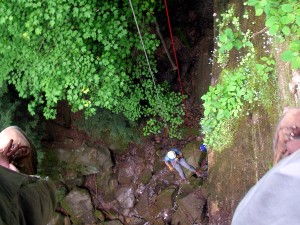Big Gee in Action













To rappel (Abseil in Europe excluding French speakers) is the act of descending a rope using friction producing bends in the rope to control speed. In the US climbers often call it just "rap" or "rapping". Cavers in the US often say "drop" or "dropping". Rappel comes to English from the French rappel whereas abseil is German for "go down rope".

I have been rappelling on and off since 1989. I know that climbers don't really consider rappelling its own activity but then climbers don't know that much about rappelling. My friends and I started very modestly with one set of minimal gear to share between us: one harness, one carabiner, one military 120' laid nylon rope. You can't get much more minimal than that. I've come a long way since then and acquired a bunch of gear and new techniques. I've used eight types of different rappel devices on all sorts of different drops including waterfalls and caves. Waterfall rappelling is possibly the most fun I've ever had on a rope. Considering some of the lackluster places I've lived, it is amazing how much rappelling I have managed to do.
One thing I've noticed over the years is the amount of interest in rappelling on the internet. It is always one of the top search terms that brings people to my website. It seems like there are a lot of people out there looking for a HOWTO document. At some point I'm going to host one of those with pictures and video. Maybe a series of HOWTOs.
Until such time as I have a great set of tutorials this short description will have to suffice, but first a warning. Rappelling can kill you and the dangers are not alway obvious. Do not use this webpage as your sole source of instruction.
As written above rappelling is the act of descending a rope using friction producing bends in the rope to control speed. There are always at least three components in a rappel: 1) Anchor, 2) Rope, and 3) Friction (rappel device). For all but low angle arm and body rappels there is also 4) Harness. Each of those four items has many considerations but for now lets just examine the friction/rappel device portion. For this exercise suitable anchor, rope, and harness are a given.
The goal is to be loosely attached to the rope so that one can slide down it, but to bend the rope in such a way as to produce sufficient friction to slide down safely. This is the heart of all rappelling. Friction must be able to overcome gravity. Everything else equal then the heavier a rappeller is the more friction they need. The maximum amount of available friction is determined by the type of rappel device, thickness/suppleness of the rope, environmental conditions such as water or ice on the rope, and lastly grip strength / glove use.
A common type of rappel device or descender is called a tube. There are a number of different models such as Black Diamond's ATC and Trango's Pyramid. A bight of rope is pushed through the tube and a carabiner is clipped to the loop. The carabiner is also clipped to the harness. So one end of the rope travels from the anchor, goes into the tube turns 180° around the carabiner, and runs back out of the tube to the brake hand. From the brake hand the rope runs down to the ground.
The friction is produced at the 180° turn around the carabiner coupled with where the rope bends around the device to the brake hand. The brake hand holds the end of the rope and pulls down to provide the remaining friction necessary to hold the rappeller's weight. Without the brake hand the rope would be "loose" in the otherwise low friction system. Even a slight amount of pressure from the brake hand produces large amounts of friction at the bends in the rope.